
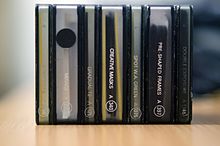
This article needs additional citations for verification .(May 2022) |
Cokin is a French manufacturer of optical filters for photography. The system allows filters such as rectangular graduated neutral density filters which are versatile in use.


This article needs additional citations for verification .(May 2022) |
Cokin is a French manufacturer of optical filters for photography. The system allows filters such as rectangular graduated neutral density filters which are versatile in use.
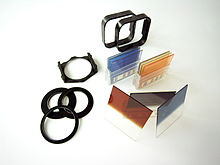
Cokin are particularly noted for their "Creative Filter System". It was invented by photographer Jean Coquin [1] and introduced in 1978. Based primarily around square filters, these require a holder which is attached to the lens via a simple adapter ring of the appropriate size. Unlike screw-thread circular filters, which are each tied to lenses of a specific diameter, those in the system can be used with any lens, provided they are large enough to cover it sufficiently. (Only the adapter ring may need changing).
The system includes a wide range of filters including color correction, plain and coloured graduated filters, diffraction, diffusion and polarizers. [2] The material is a polymer, CR-39 sometimes advertised as "organic glass".
Cokin produce various differently-sized versions of the Creative Filter System. The smallest is "A" ("Amateur", 67mm wide). The larger "P" ("Professional", 84mm wide) system covers cases where "A" filters are too small to cover the lens (or would cause problems at wider angles). The still-larger "X-Pro" filters are 130mm wide. The "A" and "P" sizes in particular are de facto standards, with many other manufacturers producing compatible filters and holders. Cokin also produce a system for 100mm-wide filters which they refer to as "Z-Pro". "X-Pro" and "Z-Pro" are designed for larger cameras. [1]

A digital camera, also called a digicam, is a camera that captures photographs in digital memory. Most cameras produced today are digital, largely replacing those that capture images on photographic film or film stock. Digital cameras are now widely incorporated into mobile devices like smartphones with the same or more capabilities and features of dedicated cameras. High-end, high-definition dedicated cameras are still commonly used by professionals and those who desire to take higher-quality photographs.

The Holga is a medium format 120 film camera, made in Hong Kong, known for its low-fidelity aesthetic.

The Four Thirds System is a standard created by Olympus and Eastman Kodak for digital single-lens reflex camera (DSLR) design and development. Four Thirds refers to both the size of the image sensor (4/3") as well as the aspect ratio (4:3). The Olympus E-1 was the first Four Thirds DSLR, announced and released in 2003. In 2008, Olympus and Panasonic began publicizing the Micro Four Thirds system, a mirrorless camera system which used the same sensor size; by eliminating the reflex mirror, the Micro Four Thirds cameras were significantly smaller than the Four Thirds cameras. The first Micro Four Thirds cameras were released in 2009 and the final Four Thirds cameras were released in 2010; by that time, approximately 15 Four Thirds camera models had been released by Olympus and Panasonic in total. The Four Thirds system was quietly discontinued in 2017, six years after the final cameras were released.
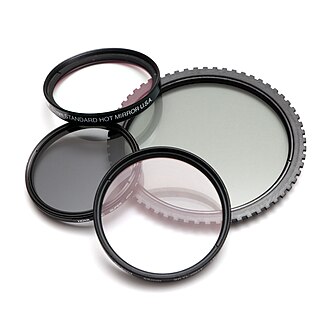
In photography and cinematography, a filter is a camera accessory consisting of an optical filter that can be inserted into the optical path. The filter can be of a square or oblong shape and mounted in a holder accessory, or, more commonly, a glass or plastic disk in a metal or plastic ring frame, which can be screwed into the front of or clipped onto the camera lens.

Mamiya Digital Imaging Co., Ltd. is a Japanese company that manufactures high-end cameras and other related photographic and optical equipment. With headquarters in Tokyo, it has two manufacturing plants and a workforce of over 200 people. The company was founded in May 1940 by camera designer Seiichi Mamiya and financial backer Tsunejiro Sugawara.

A digital single-lens reflex camera is a digital camera that combines the optics and mechanisms of a single-lens reflex camera with a solid-state image sensor and digitally records the images from the sensor.
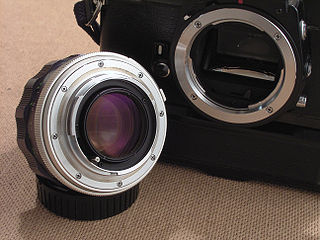
A lens mount is an interface – mechanical and often also electrical – between a photographic camera body and a lens. It is a feature of camera systems where the body allows interchangeable lenses, most usually the rangefinder camera, single lens reflex type, single lens mirrorless type or any movie camera of 16 mm or higher gauge. Lens mounts are also used to connect optical components in instrumentation that may not involve a camera, such as the modular components used in optical laboratory prototyping which join via C-mount or T-mount elements.

Sinar Photography AG is a Swiss company based in Zürich manufacturing specialized high-resolution view cameras for studio, reproduction, landscape and architecture photography.
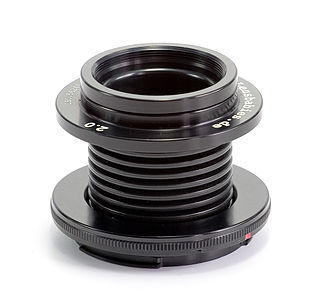
Lensbaby is a line of camera lenses for DSLR and mirrorless cameras that combines a simple lens with a bellows/ball and socket mechanism for use in special effect photography. A Lensbaby can give effects normally associated with view cameras. The lenses are for use in selective focus photography and bokeh effects.

In photography and optics, a neutral-density filter, or ND filter, is a filter that reduces or modifies the intensity of all wavelengths, or colors, of light equally, giving no changes in hue of color rendition. It can be a colorless (clear) or grey filter, and is denoted by Wratten number 96. The purpose of a standard photographic neutral-density filter is to reduce the amount of light entering the lens. Doing so allows the photographer to select combinations of aperture, exposure time and sensor sensitivity that would otherwise produce overexposed pictures. This is done to achieve effects such as a shallower depth of field or motion blur of a subject in a wider range of situations and atmospheric conditions.
The Olympus OM System was a line of 35mm single-lens reflex cameras, lenses and accessories sold by Olympus Corporation between 1972 and 2002. The range was designed by Yoshihisa Maitani, chief designer for Olympus, and his staff; OM stands for Olympus Maitani.

The Pentax K-mount, sometimes referred to as the "PK-mount", is a bayonet lens mount standard for mounting interchangeable photographic lenses to 35 mm single-lens reflex (SLR) cameras. It was created by Pentax in 1975, and has since been used by all Pentax 35 mm and digital SLRs and also the MILC Pentax K-01. A number of other manufacturers have also produced many K-mount lenses and K-mount cameras.

Image stabilization (IS) is a family of techniques that reduce blurring associated with the motion of a camera or other imaging device during exposure.
Originally produced by Minolta, then by Sony, the AF Reflex 500mm f/8 was a catadioptric photographic lens compatible with cameras using the Minolta A-mount and Sony A-mount lens mounts.

The Mamiya RZ67 is a professional medium format single-lens reflex camera manufactured by Mamiya. There are three successive models: the RZ67 Professional, RZ67 Professional II and RZ67 Professional IID. It is primarily designed for studio use, but can also be used in the field.

The Micro Four Thirds system is a standard released by Olympus Imaging Corporation and Panasonic in 2008, for the design and development of mirrorless interchangeable lens digital cameras, camcorders and lenses. Camera bodies are available from Blackmagic, DJI, JVC, Kodak, Olympus, OM System, Panasonic, Sharp, Logitech Mevo and Xiaomi. MFT lenses are produced by Cosina Voigtländer, Kowa, Kodak, Mitakon, Olympus, Panasonic, Samyang, Sharp, Sigma, SLR Magic, Tamron, Tokina, TTArtisan, Veydra, Xiaomi, Laowa, Yongnuo, Zonlai, Lensbaby, Venus Optics and 7artisans amongst others.
Iscorama was a trademark applied by ISCO Optics of Göttingen to a series of consumer-grade anamorphic lenses manufactured between the late 1960s and the beginning of the 21st century. These lenses were notable for their high optical quality and unique focusing characteristics, and with the advent of DSLR-based film making have attracted much interest from independent cinematographers and directors.

The Pentax Q is a mirrorless interchangeable-lens camera introduced by Pentax on June 23, 2011.

Nikon Z-mount is an interchangeable lens mount developed by Nikon for its mirrorless digital cameras. In late 2018, Nikon released two cameras that use this mount, the full-frame Nikon Z7 and Nikon Z6. In late 2019 Nikon announced their first Z-mount camera with an APS-C sensor, the Nikon Z50. In July 2020 the entry-level full-frame Z5 was introduced. In October 2020, Nikon announced the Nikon Z6II and Nikon Z7II, which succeed the Z6 and Z7, respectively. The APS-C lineup was expanded in July 2021, with the introduction of the retro styled Nikon Zfc, and in October 2021, Nikon unveiled the Nikon Z9, which effectively succeeds the brand's flagship D6 DSLR. The APS-C lineup was further expanded with the Nikon Z30, announced at the end of June 2022. The Nikon Z6III was announced in June 2024. In November 2024, Nikon announced the Z50II, the first APS-C camera to use the Expeed 7 processor introduced with the Z9.

The Canon RF lens mount is an interchangeable-lens mount developed by Canon for its full-frame mirrorless interchangeable-lens cameras, and featured first by the EOS R, followed by the EOS RP. The RF mount was announced in September 2018. In May 2022, Canon announced APS-C EOS R cameras and RF-S lenses designed for these cameras.